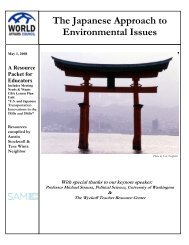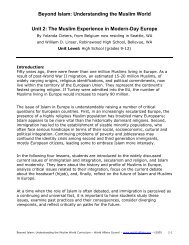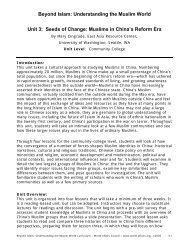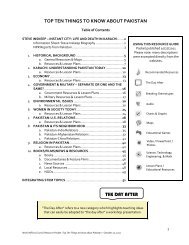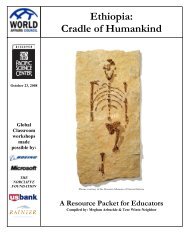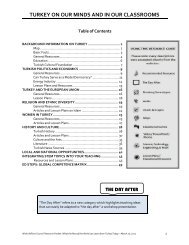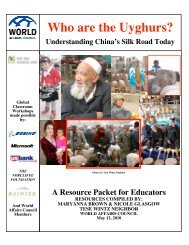If King Tut Could Talk - World Affairs Council
If King Tut Could Talk - World Affairs Council
If King Tut Could Talk - World Affairs Council
- No tags were found...
Create successful ePaper yourself
Turn your PDF publications into a flip-book with our unique Google optimized e-Paper software.
The Arab Spring and New DemocracyDiscover: Scientists of the Arab Spring (1/3/2012)http://discovermagazine.com/2012/jan-feb/11When Ahmed Zewail first heard of the popular revolt against Egyptian President Hosni Mubarak onJanuary 25, 2011, he immediately left for Cairo. “It was a very emotional time. I have family in Egypt, andI owe the country my early education,” says Zewail, who is a professor of chemistry at Caltech. “I knew Ihad to take action.”The Guardian – Arab Spring: An Interactive Timeline of Middle East Protests (1/5/2012)http://www.guardian.co.uk/world/interactive/2011/mar/22/middle-east-protest-interactive-timelineThis interactive timeline traces key events of the revolutions across the Middle East and Africa.AllAfrica: Egypt—Identity Politics and the Second republic in Egypt (OPED, 07/19/2012)http://allafrica.com/stories/201207201094.htmlWhereas the new regime of President Morsy says it is inclusive, it is troubling that the draft Egyptianconstitution says in its first article that Egypt is 'Islamic' and 'Arab' and is 'related' to Africa.Foreign Policy: Don’t Give Up on the Arab Spring (09/12/2012)http://www.foreignpolicy.com/articles/2012/09/12/dont_give_up_on_the_arab_springWhy America did the right thing in Libya—and freedom will eventually win.NY Times: Egypt News—Revolution and Aftermath (09/26/2012)http://topics.nytimes.com/top/news/international/countriesandterritories/egypt/index.htmlThis site, updated regularly, summarizes recent and past developments in Egypt.The Choices Program: Egypt’s Uprisinghttp://www.choices.edu/resources/twtn_egypt.phpUsing news media, students analyze the Arab Spring movement in Egypt.Washington Post: Middle East and North Africa in Turmoilhttp://www.washingtonpost.com/wp-srv/special/world/middle-east-protests/Anti-government protests are spreading rapidly through the Middle East and North Africa. Use this chartto keep up with all of the demonstrations, day by day. Click a country on the map or the tabs below toread more.Pulitzer Center: Lesson Plan—Writing About the “Arab Spring”http://pulitzercenter.org/education/lesson-plan/lesson-plan-writing-about-arab-springDuring the winter of 2010 and the spring of 2011, the world watched as pro-democracy protesters acrossNorth Africa and the Middle East rose up against the dictatorial regimes that had ruled their homecountries for years. The long-term political, social, and economic ramifications of these revolutionsremain to be seen, but there is much to study in the factors that led to these large-scale people’smovements, and the intended and unintended consequences as countries across the region seekdemocratic reforms.How can you use these articles?• Give students different articles to read and do a jigsaw activity in which they create their own timeline ofevents of the Arab Spring.• Make connections and find differences among Egypt’s uprising and other revolutions.• Discuss how social media and technology affect civic involvement and revolutions.• Compare and contrast life in Egypt today with that of life in ancient Egypt.<strong>World</strong> <strong>Affairs</strong> <strong>Council</strong> Resource Packet: Pacific Science Center Presents—The Golden <strong>King</strong> and the Great Pharaoh: November 1, 201231



